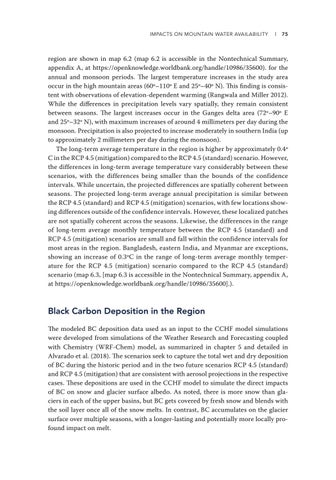Impacts on Mountain Water Availability l 75
region are shown in map 6.2 (map 6.2 is accessible in the Nontechnical Summary, appendix A, at https://openknowledge.worldbank.org/handle/10986/35600). for the annual and monsoon periods. The largest temperature increases in the study area occur in the high mountain areas (60o–110o E and 25o–40o N). This finding is consistent with observations of elevation-dependent warming (Rangwala and Miller 2012). While the differences in precipitation levels vary spatially, they remain consistent between seasons. The largest increases occur in the Ganges delta area (72o–90o E and 25o–32o N), with maximum increases of around 4 millimeters per day during the monsoon. Precipitation is also projected to increase moderately in southern India (up to approximately 2 millimeters per day during the monsoon). The long-term average temperature in the region is higher by approximately 0.4o C in the RCP 4.5 (mitigation) compared to the RCP 4.5 (standard) scenario. However, the differences in long-term average temperature vary considerably between these scenarios, with the differences being smaller than the bounds of the confidence intervals. While uncertain, the projected differences are spatially coherent between seasons. The projected long-term average annual precipitation is similar between the RCP 4.5 (standard) and RCP 4.5 (mitigation) scenarios, with few locations showing differences outside of the confidence intervals. However, these localized patches are not spatially coherent across the seasons. Likewise, the differences in the range of long-term average monthly temperature between the RCP 4.5 (standard) and RCP 4.5 (mitigation) scenarios are small and fall within the confidence intervals for most areas in the region. Bangladesh, eastern India, and Myanmar are e xceptions, showing an increase of 0.3ºC in the range of long-term average monthly temperature for the RCP 4.5 (mitigation) scenario compared to the RCP 4.5 (standard) scenario (map 6.3, [map 6.3 is accessible in the Nontechnical Summary, appendix A, at https://openknowledge.worldbank.org/handle/10986/35600].).
Black Carbon Deposition in the Region The modeled BC deposition data used as an input to the CCHF model simulations were developed from simulations of the Weather Research and Forecasting coupled with Chemistry (WRF-Chem) model, as summarized in chapter 5 and detailed in Alvarado et al. (2018). The scenarios seek to capture the total wet and dry deposition of BC during the historic period and in the two future scenarios RCP 4.5 (standard) and RCP 4.5 (mitigation) that are consistent with aerosol projections in the respective cases. These depositions are used in the CCHF model to simulate the direct impacts of BC on snow and glacier surface albedo. As noted, there is more snow than glaciers in each of the upper basins, but BC gets covered by fresh snow and blends with the soil layer once all of the snow melts. In contrast, BC accumulates on the glacier surface over multiple seasons, with a longer-lasting and potentially more locally profound impact on melt.




